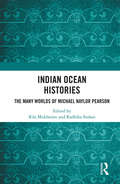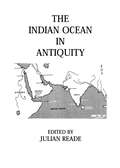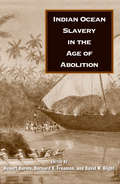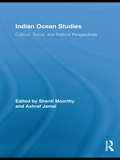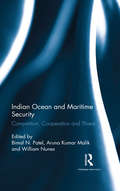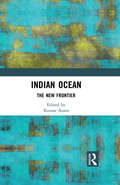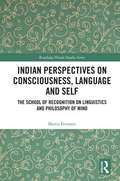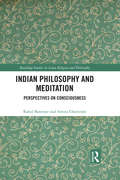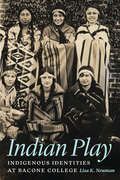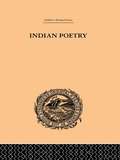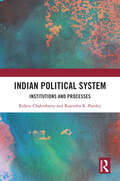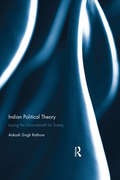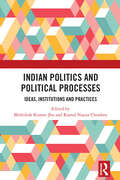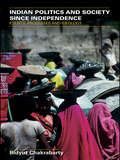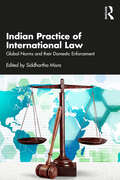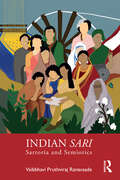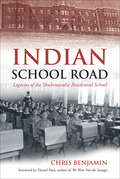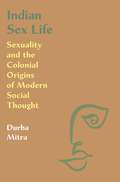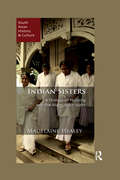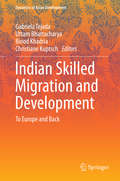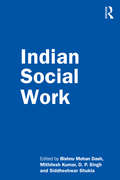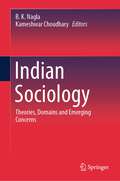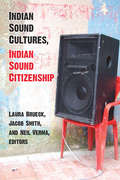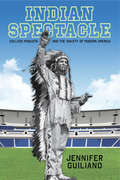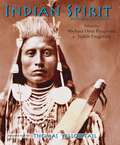- Table View
- List View
Indian Ocean Histories: The Many Worlds of Michael Naylor Pearson
by Radhika Seshan Rila MukherjeeThis book offers a global history of the Indian Ocean and focuses on a holistic perspective of the worlds of water. It builds on maritime historian Michael Naylor Pearson’s works, his unorthodox approach and strong influence on the study of the Indian Ocean in viewing the oceanic space as replete with human experiences and not as an artefact of empire or as the theatre of European commercial and imperial transits focused only on trade. This interdisciplinary volume presents several ways of writing the history of the Indian Ocean. The chapters explore the changing nature of Indian Ocean history through diverse themes, including state and capital, regional identities, maritime networking, South Asian immigrants, Bay of Bengal linkages, the East India Company, Indian seamen, formal and informal collaboration in imperial networking, scientific transfers, pearling, the issues of colonial copyright, customs, excise and port cities. The volume will be useful to scholars and researchers of global history, modern history, maritime history, medieval history, Indian history, colonial history and world history.
Indian Ocean In Antiquity
by ReadeFirst published in 1996. Routledge is an imprint of Taylor & Francis, an informa company.
Indian Ocean Slavery in the Age of Abolition
by David W. Blight Robert W. Harms Bernard K. FreamonWhile the British were able to accomplish abolition in the trans-Atlantic world by the end of the nineteenth century, their efforts paradoxically caused a great increase in legal and illegal slave trading in the western Indian Ocean. Bringing together essays from leading authorities in the field of slavery studies, this comprehensive work offers an original and creative study of slavery and abolition in the Indian Ocean world during this period. Among the topics discussed are the relationship between British imperialism and slavery; Islamic law and slavery; and the bureaucracy of slave trading.
Indian Ocean Studies: Cultural, Social, and Political Perspectives (Routledge Indian Ocean Series)
by Shanti Moorthy Ashraf JamalThe Indian Ocean is famously referred to as the "cradle of globalization," as it facilitated cultural and economic exchanges between Africa, the Arab world, the Indian subcontinent, Southeast Asia, and China, for 5000 years prior to European presence in the region. As this ocean's significance has gained increasing attention from scholars in recent years, few have examined the 'human' dimensions in Indian Ocean exchanges. Including the work of historians, geographers, anthropologists and literary analysts, each essay in this volume addresses a specific human factor, such as the fate of the creole in the Bay of Bengal, creolization as a globalized phenomenon, migrancy and diaspora, the lives of seafarers then and now, and the lives of those who inhabit the ocean's littoral. This volume is a necessary addition to the field of Indian Ocean studies.
Indian Ocean and Maritime Security: Competition, Cooperation and Threat
by Bimal N. Patel Aruna Kumar Malik William NunesThis book provides a synoptic view of the Indian Ocean and maritime security in its contested waters. Using a historical approach, it reveals vital links to events in the present day. The volume: Highlights the competition between major Asian powers to control the ‘String of Pearls’ — a reference to the Chinese attempts at controlling the Indian Ocean periphery. Shows that cooperation amongst the major powers of the region could abate the threat of the potential of conflict becoming global and inviting external intervention. Discusses India’s Look-East policy and the deepening relation between India and the Association of Southeast Asian Nations (ASEAN). Argues for the need of Indian Ocean states and particularly the South Asian Association for Regional Cooperation (SAARC) members of the Indian Ocean Rim Association (IORA) to look afresh at their political and security issues and common interests. Suggests measures for evolving a robust mechanism of maintaining the Indian Ocean as a sustainable zone of commerce, energy, security and peace rather than threat. A major contribution on a critical area in Asian geopolitics, this volume will be useful to scholars and researchers of international relations, politics, defence studies and maritime security studies, along with strategic affairs experts and think tanks.
Indian Ocean: The New Frontier
by Kousar J. AzamThe present volume curates papers presented at an international conference organized at OUCIP to engage with the oceanic turn in different fields of knowledge embracing Social Sciences, Humanities and, Physical Sciences to project the Indian Ocean as the new frontier of research across various disciplines. The papers are divided into four sections: The Oceanic Reach has papers reflecting on the received knowledge regarding the historical role and reach of the Indian Ocean and providing new insights in the evolving dynamics of the region.The section on Literature and Culture has essays reflecting the different trajectories within Humanities and Cultural Studies through which Indian Ocean has stimulated the imagination of scholars, intellectuals, diasporic writers, and culture historians.The section on Roots and Routes includes accounts of the historical, cultural, religious, trade and diasporic linkages across oceanic communities inhabiting the vast expanse of the Indian Ocean.The final section on Power Games includes papers that deal with the increasing interests of various international powers in the Indian Ocean region particularly in the context of the shift from the Asian land mass to the enormous presence of the Indian Ocean, and the economic, political and strategic significance that it has for the entire region.Taken together these contributions offer both an opportunity and a challenge for interested scholars to engage with Indian Ocean as a new frontier of knowledge with enormous potential for research and exploration. Please note: Taylor & Francis does not sell or distribute the Hardback in India, Pakistan, Nepal, Bhutan, Bangladesh and Sri Lanka
Indian Perspectives on Consciousness, Language and Self: The School of Recognition on Linguistics and Philosophy of Mind (Routledge Hindu Studies Series)
by Marco FerranteThis book examines the theory of consciousness developed by the school of Recognition, an Indian philosophical tradition that thrived around the tenth c. CE in Kashmir, and argues that consciousness has a linguistic nature. It situates the doctrines of the tradition within the broader Indian philosophical context and establishes connections with the contemporary analytic debate. The book focuses on Utpaladeva and Abhinavagupta (tenth c. CE), two Hindu intellectuals belonging to the school of Recognition, Pratyabhijñā in Sanskrit. It argues that these authors promoted ideas that bear a strong resemblance with contemporary ‘higher–order theories’ of consciousness. In addition, the book explores the relationship between the thinkers of the school of Recognition and the thought of the grammarian/philosopher Bhartṛhari (fifth c. CE). The book bridges a gap that still exists between scholars engaged with Western traditions and Sanskrit specialists focused on textual materials. In doing so, the author uses concepts from contemporary philosophy of mind to illustrate the Indian arguments and an interdisciplinary approach with abundant reference to the original sources. Offering fresh information to historians of Indian thought, the book will also be of interest to academics working on Non-Western Philosophy, Comparative Philosophy, Indian Philosophy, Religion, Hinduism, Tantric Studies and South Asian Studies.
Indian Philosophy and Meditation: Perspectives on Consciousness
by Rahul Banerjee Amita ChatterjeeIndia has a rich tradition of meditative practices designed to study the phenomenon of consciousness. From the distant past to the present, India has evolved a unique psychological culture with grand unifying themes and universal modes of meditative practice. This book provides a detailed analysis of classical and modern Indian views on consciousness along with their related meditative methods. It offers a critical analysis of three distinct trends of Indian thought, viz., a dualistic mode of understanding and realizing consciousness in Hindu Sāṃkhya, an interactive mode in early Buddhist abhidhamma, and the evolutionary transformational mode in the teachings of the twentieth-century sage Sri Aurobindo. This book explores the unifying features in Indian first person practices with regard to consciousness and the importance of these applied psychological practices and their associated understanding of our conscious inner lives. The most striking feature of the work is that side by side theoretical exposition of consciousness, it includes a number of worksheets which explain how to use meditation to achieve relaxation as well as cognitive ‘maps’ of the different levels of conscious states and instruction and how one can traverse from one state to another. The final chapter explores Sri Aurobindo who introduced new and decisive Indian spiritual thought and practice to India in the form of Integral Yoga. This innovative book will be of interest to scholars studying Indian philosophy, Indian religion and the emerging field of contemplation studies.
Indian Play: Indigenous Identities at Bacone College
by Lisa K. NeumanWhen Indian University—now Bacone College—opened its doors in Indian Territory (now Oklahoma) in 1880, it was a small Baptist institution designed to train young Native Americans to be teachers and Christian missionaries among their own people and to act as agents of cultural assimilation. From 1927 to 1957, however, Bacone College changed course and pursued a new strategy of emphasizing the Indian identities of its students and projecting often-romanticized images of Indianness to the non-Indian public in its fund-raising campaigns. Money was funneled back into the school as administrators hired Native American faculty who in turn created innovative curricular programs in music and the arts that encouraged their students to explore and develop their Native identities. Through their frequent use of humor and inventive wordplay to reference Indianness—&“Indian play&”—students articulated the (often contradictory) implications of being educated Indians in mid-twentieth-century America. In this supportive and creative culture, Bacone became an &“Indian school,&” rather than just another &“school for Indians.&”In examining how and why this transformation occurred, Lisa K. Neuman situates the students&’ Indian play within larger theoretical frameworks of cultural creativity, ideologies of authenticity, and counterhegemonic practices that are central to the fields of Native American and indigenous studies today.
Indian Poetry
by Edward ArnoldFirst published in 2000. Routledge is an imprint of Taylor & Francis, an informa company.
Indian Political System: Institutions and Processes
by Bidyut Chakrabarty Rajendra K. PandeyThis volume examines the distinct structural characteristics of Indian politics and unearths significant sociopolitical and economic processes which are critical to the political articulation of governance in the country. It reflects on the foundational values of Indian polity, the emergence of the nation post-colonialism, the structural fluidity of federalism in India, and the changing nature of the planning process in the country. The book also studies the electoral processes, social movements, party system, local and state governance. Apart from analyzing corruption and public grievance systems, the volume also probes into significant issues in Indian politics. This book will be useful to the students, researchers and faculty working in the field of political science, public administration, political sociology, political economy and post-colonial contemporary Indian politics in particular. It will also be an invaluable and interesting reading for those interested in South Asian studies.
Indian Political Theory: Laying the Groundwork for Svaraj
by Aakash Singh RathoreAt present, a nativist turn in Indian political theory can be observed. There is a general assumption that the indigenous thought to which researchers are supposed to be (re)turning may somehow be immediately visible by ignoring the colonization of the mind and polity. In such a conception of svaraj (which can be translated as ‘authentic autonomy’), the tradition to be returned to would be that of the indigenous elites. In this book, this concept of svaraj is defined as a thick conception, which links it with exclusivist notions of spirituality, profound anti-modernity, exceptionalistic moralism, essentialistic nationalism and purism. However, post-independence India has borne witness to an alternative trajectory: a thin svaraj. The author puts forward a workable contemporary ideal of thin svaraj, i.e. political, and free of metaphysical commitment. The model proposed is inspired by B.R. Ambedkar's thoughts, as opposed to the thick conception found in the works of M.K. Gandhi, KC Bhattacharya and Ramachandra Gandhi. The author argues that political theorists of Indian politics continue to work with categories and concepts alien to the lived social and political experiences of India's common man, or everyday people. Consequently, he emphasises the need to decolonize Indian political theory, and rescue it from the grip of western theories, and fascination with western modes of historical analysis. The necessity to avoid both universalism and relativism and more importantly address the political predicaments of ‘the people’ is the key objective of the book, and a push for a reorientation of Indian political theory. An interesting new interpretation of a contemporary ideal of svaraj, this analysis takes into account influences from other cultures and sources as well as eschews thick conceptions that stifle imaginations and imaginaries. This book will be of interest to academics in the fields of philosophy, political science, sociology, literature and cultural studies in general and contemporary political theory, South Asian and Indian politics and political theory in particular.
Indian Politics and Political Processes: Ideas, Institutions and Practices
by Mithilesh Kumar Jha Kamal Nayan ChoubeyIndian Politics and Political Processes explores the key ideas, foundations, continuities, major shifts and challenges to the state and democracy in modern India. The book presents an in-depth analysis of recent issues and challenges confronting the Indian state and politics. Presenting a comprehensive account of the major trajectories of Indian politics, this book introduces the readers to the existing literature and enables them to think critically about major issues and institutions of politics and democracy. The chapters engage critically with the historical antecedents, major debates, and recent developments. The book also elaborately deals with issues such as populism, religious movements, minority rights, health, and the environment, which are often ignored or side-lined in the available literature on Indian politics and political processes. The book will be useful to the students, teachers and researchers pursuing courses in political science, South Asian Studies, and international/global politics and economics. It will also be an informative read for those interested in contemporary South Asian politics.
Indian Politics and Society since Independence: Events, Processes and Ideology
by Bidyut ChakrabartyFocusing on politics and society in India, this book explores new areas enmeshed in the complex social, economic and political processes in the country. Linking the structural characteristics with the broader sociological context, the book emphasizes the strong influence of sociological issues on politics, such as social milieu shaping and the articulation of the political in day-to-day events. Political events are connected with the ever-changing social, economic and political processes in order to provide an analytical framework to explain ‘peculiarities’ of Indian politics. Bidyut Chakrabarty argues that three major ideological influences of colonialism, nationalism and democracy have provided the foundational values of Indian politics. Structured thematically and chronologically, this work is a useful resource for students of political science, sociology and South Asian studies.
Indian Practice of International Law: Global Norms and their Domestic Enforcement
by Siddhartha MisraThis book engages with different aspects of India’s practice of international law. It covers a diverse range of areas such as human rights, humanitarian law, migration, diplomacy, extradition, environment, trade, investment, taxation, cyberspace, data protection, maritime, and intellectual property to showcase India’s strong commitment to respect and observe international law.The volume discusses various themes which include: Legal and constitutional framework; Air, space, and atomic energy; Environment; Sea and maritime law; Trade, investment, and taxation; Conflict of laws; IT and data protection; Human rights and humanitarian law; Issues of refugees and internally displaced persons; Extradition and diplomatic immunities; Intellectual property; International obligations. The essays in this book also establish the linkage between observance of international law and bilateral and multilateral relations between different countries.Comprehensive and analytical, this book will be useful for scholars and researchers of law, international law, human rights, and foreign policy. It will also be an invaluable companion for professionals in law firms and think tanks, bureaucrats, and diplomats.
Indian Sari: Sartoria and Semiotics
by Vaibbhavi Pruthviraj RanavaadeThe sari has remained an essential part of culture, tradition and fashion in South Asia and India through many centuries. This book examines the variety of meanings which it carries as a symbol of Indian femininity and tradition as well as a means of creative fashion expression for modern India. It discusses the semiotic interpretations of the sari today by understanding its significance for traditional weavers, designers and people who wear saris at home, work or for religious or cultural occasions. Through surveys, interactions and interviews, the author explores the shared experience of wearing saris in different social and cultural settings across economic groups in farms and boardrooms as well as a means of creative expression for young Indians. It also looks at the processes involved in making traditional saris today, draping and weaving styles, buying behaviour, saris in pop-culture, pride parades and Bollywood and interpretations of what the sari signifies in different socio-economic circles in India. This book will be of interest to students of fashion, design, fashion business, history and cultural studies. It will also be useful for professionals working in the fashion industry and designers.
Indian School Road: Legacies of the Shubenacadie Residential School
by Chris BenjaminThe scandalous history of neglect, abuse, and exploitation at a residential school for children—and the ongoing effects in the decades since it closed.In Indian School Road, journalist Chris Benjamin tackles the controversial and tragic history of Canada’s Shubenacadie Indian Residential School, its predecessors, and its lasting effects, giving voice to multiple perspectives for the first time. Benjamin integrates research, interviews, and testimonies to guide readers through the varied experiences of students, principals, and teachers over the school’s nearly forty years of operation, from 1930 to 1967, and beyond. Exposing the raw wounds of the twenty-first-century Truth and Reconciliation Commission, as well as the struggle for an inclusive Mi’kmaw education system, Indian School Road is a comprehensive and compassionate narrative history of the school that uneducated hundreds of Aboriginal children.
Indian Sex Life: Sexuality and the Colonial Origins of Modern Social Thought
by Durba MitraDuring the colonial period in India, European scholars, British officials, and elite Indian intellectuals—philologists, administrators, doctors, ethnologists, sociologists, and social critics—deployed ideas about sexuality to understand modern Indian society. In Indian Sex Life, Durba Mitra shows how deviant female sexuality, particularly the concept of the prostitute, became foundational to this knowledge project and became the primary way to think and write about Indian society.Bringing together vast archival materials from diverse disciplines, Mitra reveals that deviant female sexuality was critical to debates about social progress and exclusion, caste domination, marriage, widowhood and inheritance, women's performance, the trafficking of girls, abortion and infanticide, industrial and domestic labor, indentured servitude, and ideologies about the dangers of Muslim sexuality. British authorities and Indian intellectuals used the concept of the prostitute to argue for the dramatic reorganization of modern Indian society around Hindu monogamy. Mitra demonstrates how the intellectual history of modern social thought is based in a dangerous civilizational logic built on the control and erasure of women's sexuality. This logic continues to hold sway in present-day South Asia and the postcolonial world.Reframing the prostitute as a concept, Indian Sex Life overturns long-established notions of how to write the history of modern social thought in colonial India, and opens up new approaches for the global history of sexuality.
Indian Sisters: A History of Nursing and the State, 1907–2007 (South Asian History and Culture)
by Madelaine HealeyHealth and medicine cannot be understood without considering the role of nurses, both as professionals and as working women. In India, unlike other countries, nurses have suffered an exceptional degree of neglect at the hands of state, a situation that has been detrimental to the quality of both rural and urban health care. Charting the history of the development of nursing in India over 100 years, Indian Sisters examines the reasons why nurses have so consistently been sidelined and excluded from health care governance and policymaking. The book challenges the routine suggestion that nursing’s poor status is mainly attributable to socio-cultural factors, such as caste, limitations on female mobility and social taboos. It argues instead that many of its problems are due to an under-achieved relationship between a patriarchal state on the one hand, and weak professional nursing organisations shaped by their colonial roots on the other. It also explores how the recent phenomenon of large-scale emigration of nurses to the West (leading to better pay, working conditions and career prospects) has transformed the profession, lifting its status dramatically. At the same time, it raises questions about the implications of emigration for the fate of health care system in India. An important contribution to the growing academic genre of nursing history, the book is essential reading for scholars and students of health care, the history of medicine, gender and women’s studies, sociology, and migration studies. It will also be useful to policymakers and health professionals.
Indian Skilled Migration and Development
by Christiane Kuptsch Gabriela Tejada Uttam Bhattacharya Binod KhadriaThis edited contribution explores strategies and measures for leveraging the potential of skilled diasporas and for advancing knowledge-based evidence on return skilled migration and its impact on development. By taking the example of Indian skilled migration, this study identifies ways of involving returned skilled migrants in home country development as well as proposes approaches to engage the diaspora in development. As high-skill immigration from India to mainland Europe is a rather recent phenomenon, the activities of Indian professionals in Europe are under-researched. The findings have wider application in contributing to the policy dialogue on migration and development, specifically to the advantage for developing and emerging economies. The book employs an interdisciplinary, two-fold approach: The first part of the research looks at how international exposure affects the current situation of skilled returnees in India. The second, European, part of the research examines migration policies, labour market regulations and other institutional settings that enable or hinder skilled Indians' links with the country of origin. Structural differences between the host countries may facilitate different levels of learning opportunities; thus, this book identifies good practices to promote the involvement of Indian skilled diaspora in socio-economic development. In applying the framework of diaspora contributions as well as the return channel to study the impact on India, the book draws on qualitative and quantitative research methods consisting of policy analysis, in-depth interviews with key experts and skilled migrants and on data sets collected specifically for this study.
Indian Social Work
by Bishnu Mohan Dash; Mithilesh Kumar; D. P. Singh; Siddheshwar ShuklaThis book provides multiple frameworks and paradigms for social work education which integrates indigenous theories and cultural practices. It focuses on the need to diversify and reorient social work curriculum to include indigenous traditions of service, charity and volunteerism to help social work evolve as a profession in India. The volume analyzes the history of social work education in India and how the discipline has adapted and changed in the last 80 years. It emphasizes the need for the Indianization of social work curriculum so that it can be applied to the socio-cultural contours of a diverse Indian society. The book delineates strategies and methods derived from meditation, yoga, bhakti and ancient Buddhist and Hindu philosophy to prepare social work practitioners with the knowledge, and skills, that will support and enhance their ability to work in partnership with diverse communities and indigenous people. This book is essential reading for teachers, educators, field practitioners and students of social work, sociology, religious studies, ancient philosophy, law and social entrepreneurship. It will also interest policy makers and those associated with civil society organizations.
Indian Sociology: Theories, Domains and Emerging Concerns
by B. K. Nagla Kameshwar ChoudharyThis book presents a critical and reflective view of fundamental theoretical orientations, thematic domains, and current debates in Indian sociology. It covers the growth of sociology as an academic and pedagogical subject, with four main parts. Part I discusses important theoretical orientations in Indian sociology, including Indological and civilizational approaches, as well as the contributions of an eminent sociologist and pioneer in Indian sociology, Professor Yogendra Singh, concerning the sociology of knowledge, liberal democracy, and the relevance of his concept of Islamization in the study of Indian society. Part II examines substantive areas of study such as caste, class, and tribe. Part III reflects on specific topics of current concern in Indian sociology, such as emerging vistas and futures, globalization, and rethinking area studies for planetary conversations. This book is highly relevant for postgraduate students and researchers in sociology, social anthropology, and social sciences.
Indian Sound Cultures, Indian Sound Citizenship
by Jacob Smith Neil Verma Laura BrueckFrom the cinema to the recording studio to public festival grounds, the range and sonic richness of Indian cultures can be heard across the subcontinent. Sound articulates communal difference and embodies specific identities for multiple publics. This diversity of sounds has been and continues to be crucial to the ideological construction of a unifying postcolonial Indian nation-state. Indian Sound Cultures, Indian Sound Citizenship addresses the multifaceted roles sound plays in Indian cultures and media, and enacts a sonic turn in South Asian Studies by understanding sound in its own social and cultural contexts. “Scapes, Sites, and Circulations” considers the spatial and circulatory ways in which sound “happens” in and around Indian sound cultures, including diasporic cultures. “Voice” emphasizes voices that embody a variety of struggles and ambiguities, particularly around gender and performance. Finally, “Cinema Sound” make specific arguments about film sound in the Indian context, from the earliest days of talkie technology to contemporary Hindi films and experimental art installations. Integrating interdisciplinary scholarship at the nexus of sound studies and South Asian Studies by questions of nation/nationalism, postcolonialism, cinema, and popular culture in India, Indian Sound Cultures, Indian Sound Citizenship offers fresh and sophisticated approaches to the sonic world of the subcontinent.
Indian Spectacle
by Jennifer GuilianoAmid controversies surrounding the team mascot and brand of the Washington Redskins in the National Football League and the use of mascots by K-12 schools, Americans demonstrate an expanding sensitivity to the pejorative use of references to Native Americans by sports organizations at all levels. In Indian Spectacle, Jennifer Guiliano exposes the anxiety of American middle-class masculinity in relation to the growing commercialization of collegiate sports and the indiscriminate use of Indian identity as mascots. Indian Spectacle explores the ways in which white, middle-class Americans have consumed narratives of masculinity, race, and collegiate athletics through the lens of Indian-themed athletic identities, mascots, and music. Drawing on a cross-section of American institutions of higher education, Guiliano investigates the role of sports mascots in the big business of twentieth-century American college football in order to connect mascotry to expressions of community identity, individual belonging, stereotyped imagery, and cultural hegemony. Against a backdrop of the current level of the commercialization of collegiate sports--where the collective revenue of the fifteen highest grossing teams in Division I of the National Collegiate Athletic Association (NCAA) has well surpassed one billion dollars--Guiliano recounts the history of the creation and spread of mascots and university identities as something bound up in the spectacle of halftime performance, the growth of collegiate competition, the influence of mass media, and how athletes, coaches, band members, spectators, university alumni, faculty, and administrators, artists, writers, and members of local communities all have contributed to the dissemination of ideas of Indianness that is rarely rooted in native people's actual lives.
Indian Spirit, Revised and Enlarged
by Judith Fitzgerald Michael Oren FitzgeraldThrough its striking combination of stirring oratory and majestic portraiture from the Plains Indian pre-reservation &“old-timers,&” Indian Spirit reveals the very heart of the traditional Native American life-way: a world where dignity of soul, nobility of sentiments, discipline of gesture, and a sense of the Great Spirit in all things, reigned supreme. This heroic ideal of the Native American, blending the courage of the warrior with the wisdom of the priest, stands as a timeless exemplar for all peoples.
